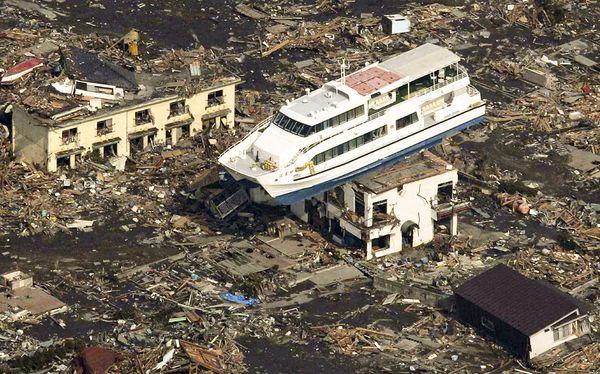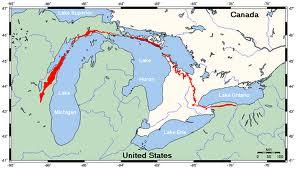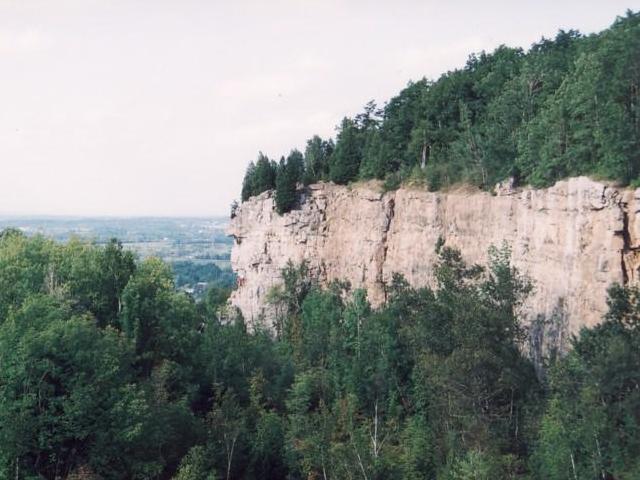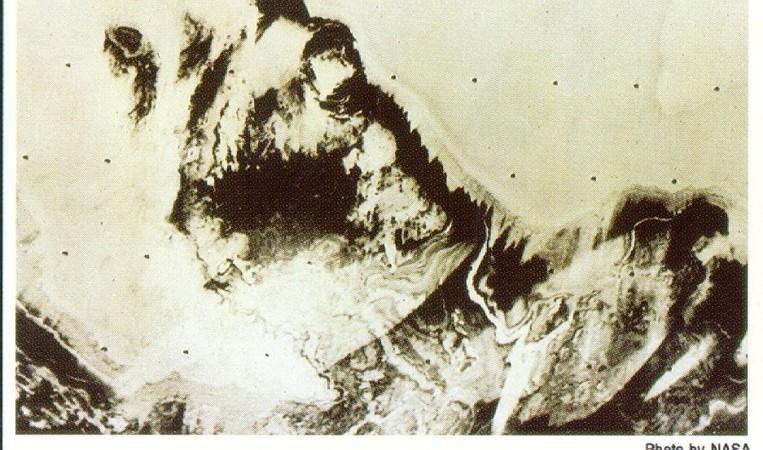
როდესაც 2014 წელს ფილმი „ნოე“ გამოვიდა, დიდი აჟიოტაჟი და დავა გამოიწვია. კრიტიკოსებმა ეჭვქვეშ დააყენეს სიუჟეტური ხაზი, რადგან ის ბიბლიურ მონათხრობს არ შეესაბამებოდა. ისლამურ სამყაროში რამდენიმე ქვეყანამ აკრძალა ფილმი, რადგან მასში ვიზუალურად წინასწარმეტყველი იყო გამოსახული, რაც მკაცრად აკრძალულია ისლამში. თუმცა, ეს საკითხები უმნიშვნელოა გაცილებით ღრმა და ხანგრძლივ დაპირისპირებასთან შედარებით.
მართლა მოხდა ასეთი მსოფლიო წარღვნა? ეს კითხვა ნამდვილად ღირს დასმას.
მსოფლიოს მრავალ კულტურაში დიდი წარღვნის შესახებ ლეგენდებია შემონახული . სხვა კატასტროფების, როგორიცაა მიწისძვრები, ვულკანები, ხანძრები ან ჭირები, შესახებ მსგავსი მითები არ არსებობს ამ ფართოდ გავრცელებულ კულტურაში, როგორც ეს წარღვნის ისტორიებია. ამრიგად, არსებობს ანთროპოლოგიური მტკიცებულებები წარსული გლობალური წარღვნის მოგონებების შესახებ. მაგრამ არსებობს თუ არა დღეს რაიმე ფიზიკური მტკიცებულება, რომელიც მიუთითებს ნოეს წარსულში მომხდარ წარსულში მომხდარზე?
ცუნამებში დანახული წყალდიდობის წყლის მოძრავი ძალა

დავიწყოთ იმით, თუ რას მოუტანდა დედამიწას ასეთი წარღვნა, თუ ის მოხდებოდა. რა თქმა უნდა, ასეთი წარღვნა გულისხმობს წარმოუდგენელი რაოდენობით წყლის გადაადგილებას დიდი სიჩქარითა და სიღრმეებით კონტინენტურ დისტანციებზე. დიდი რაოდენობით წყლის მოძრაობას, რომელიც დიდი სიჩქარით მოძრაობს, აქვს დიდი კინეტიკური ენერგია (KE=½*მასური*სიჩქარე 2 ). სწორედ ამიტომ არის წყალდიდობები ასეთი დამანგრეველი. განვიხილოთ 2011 წლის ცუნამის სურათები, რომელმაც იაპონია გაანადგურა . იქ ჩვენ ვნახეთ წყლის კინეტიკურმა ენერგიამ გამოიწვია უზარმაზარი ზიანი. ცუნამი ადვილად იჭერდა და იტანდა დიდ ობიექტებს, როგორიცაა მანქანები, სახლები და ნავები. მან თავის გზაზე ბირთვული რეაქტორებიც კი დააზიანა.


ნალექები და დანალექი ქანები

ამგვარად, როდესაც წყლის სიჩქარე იზრდება, ის სულ უფრო და უფრო დიდ ნალექს აიღებს და გადაიტანს. წყლის სიჩქარის ზრდასთან ერთად თან გადააქვს მიწის ნაწილაკები, შემდეგ ქვიშა, შემდეგ ქვები და ლოდებიც კი.
სწორედ ამიტომ არის ადიდებული და ადიდებული მდინარეები ყავისფერი. ისინი სავსეა ნალექით (ნიადაგითა და ქანებით), რომელიც შეგროვდა იმ ზედაპირებიდან, რომლებზეც წყალი გადაადგილდა.


როდესაც წყალი შენელებას იწყებს და კინეტიკურ ენერგიას კარგავს, ის ამ ნალექს უშვებს. ეს ნალექი ლამინირებულ ფენებად ილექება, რომლებიც ბლინების ფენებს ჰგავს, რაც იწვევს კონკრეტული სახის ქანის – დანალექი ქანის წარმოქმნას.

დანალექი ქანების ისტორიაში ჩამოყალიბება
დანალექი ქანის ამოცნობა მისი ერთმანეთზე დაწყობილი, დამახასიათებელი ბლინისებრი ფენებით შეგიძლიათ . ქვემოთ მოცემულ ფიგურაზე გამოსახულია დაახლოებით 20 სმ სისქის (საზომი ლენტიდან) დანალექი ფენები, რომლებიც 2011 წელს იაპონიაში დამანგრეველი ცუნამის დროს დაილექა.

ცუნამიები და მდინარის წყალდიდობები თავიანთ კვალს ტოვებენ ამ დანალექ ქანებში დიდი ხნის შემდეგაც კი, როდესაც წყალდიდობა უკან დაიხევს და ყველაფერი ნორმალურად დაუბრუნდება.
მაშ ასე, ვპოულობთ თუ არა დანალექ ქანებს, რომლებიც, ანალოგიურად, გლობალური წარღვნის საფირმო ნიშნებია, რომლის შესახებაც ბიბლია აცხადებს, რომ მოხდა? როდესაც ამ კითხვას დასვამთ და ირგვლივ მიმოიხედავთ, დაინახავთ, რომ დანალექი ქანი სიტყვასიტყვით ფარავს ჩვენს პლანეტას. ამ ტიპის ბლინებისებრი ფენოვანი ქანის შემჩნევა შეგიძლიათ გზატკეცილების ჭრილებზე. ამ დანალექი ქანს, იაპონიის ცუნამის მიერ წარმოქმნილ ფენებთან შედარებით, მათი განსხვავება მისი ზომაა. როგორც დედამიწის გვერდით, ასევე დანალექი ფენების ვერტიკალური სისქით, ისინი ცუნამის დანალექი ფენებს აჭარბებენ. განვიხილოთ დანალექი ქანების რამდენიმე ფოტო, რომლებიც გადაღებულია იმ ადგილებში, სადაც მე ვმოგზაურობდი.
დანალექი ფენები მთელ მსოფლიოში










ამგვარად, ერთმა ცუნამმა იაპონიაში ნგრევა გამოიწვია, თუმცა დატოვა დანალექი ფენები, რომლებიც სანტიმეტრებში იზომება და ხმელეთამდე რამდენიმე კილომეტრის სიგრძისაა. მაშინ რამ გამოიწვია გიგანტური და კონტინენტის მასშტაბით განლაგებული დანალექი წარმონაქმნები, რომლებიც თითქმის მთელ დედამიწაზე (ოკეანის ფსკერზე მათ შორის) გვხვდება? ვერტიკალურად ისინი ასობით მეტრს იზომება, ხოლო გვერდით ათასობით კილომეტრს. მოძრავმა წყალმა ეს უზარმაზარი ფენები წარსულში გარკვეულ მომენტში შექმნა. შეიძლება თუ არა ეს დანალექი ქანები ნოეს წარღვნის ნიშანი იყოს?
დანალექი წარმონაქმნების სწრაფი დალექვა
არავინ დავობს, რომ პლანეტას წარმოუდგენლად მასიური დანალექი ქანები ფარავს. კითხვა ფოკუსირებულია იმაზე, ჩამოაყალიბა თუ არა ერთმა მოვლენამ, ნოეს წარღვნამ, ამ დანალექი ქანების უმეტესობა. ალტერნატიულად, ხომ არ დაგროვდა ისინი დროთა განმავლობაში უფრო მცირე მოვლენების სერიამ (მაგალითად, 2011 წლის ცუნამი იაპონიაში)? ქვემოთ მოცემული სურათი ასახავს ამ მეორე კონცეფციას.

დანალექი წარმონაქმნის ამ მოდელში (რომელსაც ნეოკატასტროფიზმი ეწოდება ), დიდი დროის ინტერვალები გამოყოფს მაღალი ზემოქმედების მქონე დანალექი მოვლენების სერიას. ეს მოვლენები წინა ფენებს დანალექ ფენებს უმატებს. ამრიგად, დროთა განმავლობაში, ეს მოვლენები ქმნის უზარმაზარ წარმონაქმნებს, რომლებსაც დღეს მთელ მსოფლიოში ვხედავთ.
ნიადაგის ფორმირება და დანალექი ფენები

გვაქვს თუ არა რაიმე რეალური მონაცემები, რომლებიც დაგვეხმარება ამ ორ მოდელს შორის შედარების შეფასებაში? მათი აღმოჩენა არც ისე რთულია. ამ დანალექი წარმონაქმნების უმეტესობასთან ერთად, ვხედავთ, რომ ნიადაგის ფენები ჩამოყალიბდა. ამრიგად, ნიადაგის წარმოქმნა დანალექი დანალექის შემდეგ დროის გასვლის ფიზიკური და დაკვირვებადი მაჩვენებელია. ნიადაგი ჰორიზონტებად ეწოდება ფენებს ( A ჰორიზონტი – ხშირად მუქი ორგანული მასალით, B ჰორიზონტი – მეტი მინერალით და ა.შ.).



ზღვის ფსკერის ბიოტურბაცია და დანალექი ქანები
ოკეანის სიცოცხლე ასევე აღნიშნავს ოკეანის ფსკერის წარმოქმნისას დანალექი შრეების არსებობას მათი აქტივობის ნიშნებით. ჭიაყელა ხვრელები, მოლუსკების გვირაბები და სიცოცხლის სხვა ნიშნები (ცნობილია, როგორც ბიოტურბაცია ) სიცოცხლის საცნობელ ნიშნებს იძლევა. ვინაიდან ბიოტურბაციისთვის გარკვეული დროა საჭირო, მისი არსებობა ფენების დალექვის შემდეგ დროის სვლაზე მიუთითებს.


ნიადაგები და ბიოტურბაცია? რას ამბობენ ქანები?
ამ ცოდნით შეიარაღებულები, შეგვიძლია, ამ „დროის გავლის“ ფენების საზღვრებზე ნიადაგის ფორმირების ან ბიოტურბაციის მტკიცებულებები მოვძებნოთ. ნეოკატასტროფიზმი ხომ არ ამბობს, რომ ეს საზღვრები ხმელეთზე ან წყალქვეშ მნიშვნელოვანი პერიოდის განმავლობაში იყო გამოვლენილი. ამ შემთხვევაში, უნდა ველოდოთ, რომ ამ ზედაპირებიდან ზოგიერთს ნიადაგის ან ბიოტურბაციის ინდიკატორები განუვითარდა. როდესაც შემდგომმა წყალდიდობებმა დროის სასაზღვრო ზედაპირები დამარხეს, ნიადაგი ან ბიოტურბაციაც დამარხული იქნებოდა. შეხედეთ ზემოთ და ქვემოთ მოცემულ ფოტოებს. ხედავთ თუ არა ფენებში ნიადაგის ფორმირების ან ბიოტურბაციის რაიმე მტკიცებულებას?

ზემოთ მოცემულ ფოტოზე და ქვემოთ მოცემულ ფოტოზე ნიადაგის ფენების ან ბიოტურბაციის კვალი არ ჩანს. დააკვირდით ჰამილტონის ფერდობის ფოტოს და თქვენ ვერ ნახავთ ფენებში რაიმე ბიოტურბაციის ან ნიადაგის წარმოქმნის კვალი. ნიადაგის წარმონაქმნებს მხოლოდ ზედა ზედაპირზე ვხედავთ, რაც დროის გასვლაზე მიუთითებს მხოლოდ ბოლო ფენის დალექვის შემდეგ. ფენის ფენებში ისეთი დროის ინდიკატორების არარსებობიდან გამომდინარე, როგორიცაა ნიადაგი ან ბიოტურბაცია, როგორც ჩანს, ქვედა ფენები თითქმის ერთდროულად ჩამოყალიბდა ზედა ფენებთან. თუმცა, ეს წარმონაქმნები ვერტიკალურად დაახლოებით 50-100 მეტრის სიმაღლეზეა გადაჭიმული.

მყიფე ან დრეკადი: დანალექი ქანების დაკეცვა

წყალი დანალექ ქანებში აღწევს მაშინ, როდესაც ის თავდაპირველად დანალექი შრეების წარმოქმნას იწყებს. ამრიგად, ახლად დალექილი დანალექი შრეები ძალიან ადვილად იხრება. ისინი დრეკადია. თუმცა, ამ დანალექი შრეების გაშრობასა და გამკვრივებას მხოლოდ რამდენიმე წელი სჭირდება. როდესაც ეს ხდება, დანალექი ქანი მყიფე ხდება. მეცნიერებმა ეს 1980 წელს წმინდა ელენეს ვულკანის ამოფრქვევის შემდეგ, რასაც 1983 წელს ტბის გარღვევა მოჰყვა, შეიტყვეს. ამ დანალექი ქანების მყიფეობას მხოლოდ სამი წელი დასჭირდა.
მყიფე ქანები მოხრის სტრესის ქვეშ ტყდება. ეს დიაგრამა ასახავს პრინციპს.

მყიფე ნიაგარას ესკარპენტი
ნიაგარას ფერდობზე ქანების ამ ტიპის ჩამონგრევას ვხედავთ. ამ ნალექების დალექვის შემდეგ ისინი მყიფე გახდნენ. როდესაც მოგვიანებით აღმავალმა ბიძგმა ამ დანალექი ფენებიდან ზოგიერთი აწია, ისინი ძვრის სტრესის ქვეშ გატყდა. ამან წარმოშვა ნიაგარას ფერდობანი, რომელიც ასობით მილის სიგრძეზეა გადაჭიმული.


ამიტომ, ჩვენ ვიცით, რომ ნიაგარას ესკარპის წარმოქმნის შედეგად წარმოქმნილი აღმავალი ბიძგი მოხდა მას შემდეგ, რაც ეს დანალექი ფენები მყიფე გახდა. ამ მოვლენებს შორის საკმარისი დრო იყო იმისათვის, რომ ფენები გამკვრივებულიყო და მყიფე გამხდარიყო. ამას საუკუნეები არ სჭირდება, მაგრამ რამდენიმე წელი სჭირდება, როგორც წმინდა ელენეს მთამ აჩვენა.
მოქნილი დანალექი წარმონაქმნები მაროკოში
ქვემოთ მოცემულ ფოტოზე გამოსახულია მაროკოში გადაღებული დიდი დანალექი წარმონაქმნები. თქვენ ხედავთ, თუ როგორ იხრება ფენის წარმონაქმნი, როგორც ერთიანი ერთეული. არ არსებობს ფენის მოტეხვის არანაირი მტკიცებულება არც დაჭიმვის (დაშლის) და არც ძვრის (გვერდითი რღვევის) დროს. ამიტომ, მთელი ეს ვერტიკალური წარმონაქმნი მოხრის დროსაც დრეკადი უნდა ყოფილიყო. თუმცა, დანალექი ქანის მყიფეობას მხოლოდ რამდენიმე წელი სჭირდება. ეს ნიშნავს, რომ წარმონაქმნის ქვედა და ზედა ფენებს შორის არ შეიძლება იყოს მნიშვნელოვანი დროის ინტერვალი. თუ ამ ფენებს შორის „დროის გავლის“ ინტერვალი იქნებოდა, მაშინ ადრეული ფენები მყიფე გახდებოდა. შემდეგ ისინი დაიბზარებოდნენ და მოტყდებოდნენ წარმონაქმნის დეფორმაციის ნაცვლად.

დიდი კანიონის დრეკადი წარმონაქმნები

იგივე ტიპის მოხრას ვხედავთ დიდ კანიონში. წარსულში, ხდებოდა აღმავალი აწევა (ცნობილია, როგორც მონოკლინი ), მსგავსი იმისა, რაც ნიაგარას ესკარპმენტს დაემართა. ამან წარმონაქმნის ერთი მხარე ვერტიკალურად ერთი მილით, ანუ 1.6 კმ-ით ასწია. ამის დანახვა შეგიძლიათ აღმავალი აწევის მეორე მხარეს 7000 ფუტის სიმაღლიდან 2000 ფუტთან შედარებით. (ეს იძლევა სიმაღლის სხვაობას 5000 ფუტის ტოლს, რაც მეტრულ ერთეულებში 1.5 კმ-ს უდრის). თუმცა, ეს ფენა არ მოტყდა ისე, როგორც ნიაგარას ესკარპტი. ამის ნაცვლად, ის მოიხარა როგორც წარმონაქმნის ქვედა, ასევე ზედა ნაწილში. ეს მიუთითებს, რომ ის კვლავ დრეკადი იყო მთელი წარმონაქმნის განმავლობაში. ქვედა და ზედა ფენების დალექვას შორის საკმარისი დრო არ გასულა ქვედა ფენების მყიფედ გადასაქცევად.

ამგვარად, ამ ფენების ქვემოდან ზედა ნაწილამდე დროის ინტერვალი მაქსიმუმ რამდენიმე წელია (დრო, რომელიც დანალექი ფენების გამაგრებასა და მყიფედ გახდომას სჭირდება).
ამგვარად, ქვედა და ზედა ფენებს შორის საკმარისი დრო არ არის წყალდიდობის სერიისთვის. ქანების ეს გიგანტური ფენები ერთ ჯერზე ათასობით კვადრატული კილომეტრის ფართობზე დაილექა. ქანები ნოეს წარღვნის დამადასტურებელი საბუთია.
ნოეს წარღვნა მარსზე წარღვნის წინააღმდეგ
ნოეს წარღვნის რეალურად მომხდარი იდეა არატრადიციულია და გარკვეულ ფიქრს მოითხოვს.


მაგრამ, სულ მცირე, სასარგებლოა თანამედროვეობის ირონიის გათვალისწინება. პლანეტა მარსი ავლენს არხების წარმოქმნას და დანალექის კვალი. ამიტომ, მეცნიერები ვარაუდობენ, რომ მარსი ოდესღაც უზარმაზარი წარღვნის შედეგად დაიტბორა.
ამ თეორიის დიდი პრობლემა ის არის, რომ წითელ პლანეტაზე არავის აღმოუჩენია წყალი. თუმცა, წყალი დედამიწის ზედაპირის 2/3-ს ფარავს. დედამიწა საკმარის წყალს შეიცავს, რომ 1.5 კმ სიღრმეზე გლუვი და მომრგვალებული სფერო დაფაროს. კონტინენტის ზომის დანალექი წარმონაქმნები, რომლებიც, როგორც ჩანს, სწრაფად დაილექა დამანგრეველი კატაკლიზმისას, ფარავს დედამიწას. თუმცა, ბევრი ერესად მიიჩნევს იმ პოსტულატს, რომ მსგავსი წარღვნა ოდესმე მომხდარა ამ პლანეტაზე. მაგრამ მარსის შემთხვევაში ჩვენ აქტიურად განვიხილავთ ამას. განა ეს ორმაგი სტანდარტი არ არის?
შეიძლება ფილმ „ნოეს“ მხოლოდ ჰოლივუდური სცენარით დაწერილი მითის რეკონსტრუქციად მივიჩნიოთ. თუმცა, შესაძლოა, კიდევ ერთხელ დავფიქრდეთ, ხომ არ ყვირიან თავად კლდეები ქვის სცენარებზე დაწერილი ამ წარღვნის შესახებ.